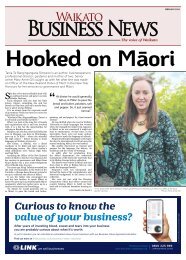Waikato Business News July/August 2018
Waikato Business News has for a quarter of a century been the voice of the region’s business community, a business community with a very real commitment to innovation and an ethos of co-operation.
Waikato Business News has for a quarter of a century been the voice of the region’s business community, a business community with a very real commitment to innovation and an ethos of co-operation.
You also want an ePaper? Increase the reach of your titles
YUMPU automatically turns print PDFs into web optimized ePapers that Google loves.
8 WAIKATO BUSINESS NEWS <strong>July</strong>/<strong>August</strong> <strong>2018</strong><br />
Conversations with Mike Neale<br />
of NAI Harcourts Hamilton<br />
Almost everyone we talk to who<br />
either owns a commercial property<br />
or looking to redevelop one,<br />
makes comments about the increasing<br />
compliance costs and skyrocketing costs<br />
to redevelop - this comes in the form of<br />
central government legislation for seismic<br />
and asbestos compliance, plus ongoing<br />
Hamilton City Council consent requirements.<br />
These consent requirements<br />
come from the associated reports (traffic<br />
impact, acoustic etc), to the often-bureaucratic<br />
red tape that is often followed to<br />
the letter of the law, whereas a different<br />
approach would often provide a significantly<br />
faster and potentially better outcome<br />
for all parties. More rules do not<br />
in my opinion provide a better outcome<br />
as can be evidenced with several in what<br />
can only be described as awful residential<br />
developments (one in Tristram Street and<br />
one in Vialou Street comes to mind immediately)<br />
that were completed several years<br />
ago - but they conform to the rules. What<br />
is often not appreciated of this bureaucratic<br />
process is the additional cost to the end<br />
user due to time delay - every consultant<br />
and scaffolding provider is seeing the<br />
benefit to their business. It’s almost becoming<br />
too complex for building owners<br />
to manage buildings themselves.<br />
ASBESTOS – A SUPER 6 ISSUE<br />
Asbestos is an international problem and<br />
there is no doubt that it is a problem. The<br />
issue being that the legislation does not<br />
differentiate between the 3 main types<br />
(white, blue and brown) of asbestos which<br />
have markedly different risk factors.<br />
On 4th April 2016, new Asbestos regulations<br />
came into force under the Health<br />
and Safety at Work Act 2015. From 1 October<br />
2016, importation of products containing<br />
asbestos was banned.<br />
As commercial and industrial property<br />
owners, buildings constructed before<br />
1990 are likely to contain asbestos materials.<br />
Materials containing asbestos are not<br />
dangerous if they are in a good condition<br />
and remain undisturbed, however we are<br />
now getting requests from purchasers and<br />
tenants as to whether ‘at risk’ buildings<br />
have had an Asbestos Report undertaken.<br />
Typically, industrial buildings are likely to<br />
contain asbestos and it can be found in:<br />
• Roof ventilators<br />
• ‘Super Six’, ‘Super Eight’<br />
roof sheeting<br />
• Skylight and manhole<br />
frames<br />
• Asbestos cement vent pipe<br />
and capping<br />
• ‘Super Six’, ‘Super Eight’ or<br />
architectural designed wall<br />
cladding<br />
• Vinyl floor tiles or sheet<br />
vinyl floor coverings<br />
• ACM woven fencing product<br />
Asbestos testing and removal<br />
is carried out by private service<br />
contractors. The Health & Safety at Work<br />
(Asbestos) regulations 2016 outline the<br />
functional requirements. Testing, removal<br />
and disposal of asbestos must be undertaken<br />
by a licensed practitioner due to the<br />
health dangers of the asbestos fibres.<br />
A SEISMIC ISSUE<br />
From 1 <strong>July</strong> 2017, the Building (Earthquake-prone<br />
Buildings) Amendment Act<br />
2016 (the Amendment Act) came into effect.<br />
The purpose is to ensure that the way<br />
buildings in New Zealand are managed<br />
for future earthquakes is consistent across<br />
the entire country. This will also provide<br />
more information for people using buildings,<br />
such as notices on earthquake-prone<br />
buildings and a public register.<br />
Due to the new legislation, this means<br />
that the Hamilton City Council’s current<br />
Mike Neale - Managing Director,<br />
NAI Harcourts Hamilton.<br />
Earthquake-Prone, Dangerous and Insanitary<br />
Buildings Policy which became operative<br />
in 2006, is now redundant.<br />
As Hamilton’s geographical location<br />
is considered to be a medium risk of having<br />
a major earthquake, this means that<br />
building owners will have 25 years to upgrade<br />
their building after such time that<br />
the Hamilton City Council send them a<br />
formal notice. Council’s in medium risk<br />
areas, have 5 years to send out formal notification.<br />
Part of the new legislation is the introduction<br />
of ‘Priority Buildings’ within<br />
high and medium seismic risk areas.<br />
Such buildings are considered to present a<br />
higher risk due to their construction type,<br />
use or location. There are two key categories<br />
of priority buildings:<br />
• certain hospitals, emergency and<br />
education buildings<br />
• buildings that include parts of<br />
unreinforced masonry that could fall in<br />
an earthquake which are located with<br />
sufficient pedestrian or vehicle traffic<br />
that warrant being a priority, such as<br />
the central city area of Hamilton.<br />
Such priority buildings will need to<br />
have their seismic work carried out in a<br />
shorter timeframe. For Hamilton, these<br />
priority buildings, will need to be upgraded<br />
in 12.5 years from receipt of official<br />
notice. Hamilton City Council is still assessing<br />
which buildings will fall under<br />
this category.<br />
The legislative requirement is to be<br />
to a minimum of 34% NBS (New Building<br />
Standard), while government departments<br />
and often large corporate tenants<br />
may have a requirement to be above 67%<br />
NBS. The issue that we are facing is that<br />
many of our buildings will not have these<br />
types of tenants, but banks for new purchases<br />
are requiring 67% NBS or costs<br />
to get buildings to this level. Surely if<br />
the building is above 34% NBS and its<br />
insured, that should be sufficient for lending?<br />
at this point if your building sits in<br />
“no man’s land” of 34% - 67% then its<br />
highly likely that you will not be able to<br />
borrow on that particular asset.<br />
For further information on The Building<br />
Act 2004 – Refer to Subpart 6A—Special<br />
provisions for earthquake-prone buildings<br />
(http://www.legislation.govt.nz/act/<br />
public/2004/0072/latest/whole.html)<br />
NAI Harcourts Hamilton<br />
Monarch Commercial Ltd MREINZ Licensed<br />
Agent REAA 2008<br />
Cnr Victoria & London Streets, HAMILTON<br />
07 850 5252 | hamilton@naiharcourts.co.nz<br />
www.naiharcourts.co.nz<br />
J1261P<br />
<strong>Waikato</strong> takes the crown<br />
in New Zealand <strong>Business</strong><br />
Case League <strong>2018</strong><br />
A team of 12 management students from<br />
the University of <strong>Waikato</strong> are relishing the<br />
sweet taste of victory in this year’s Student<br />
Development Society National <strong>Business</strong><br />
Case League <strong>2018</strong>.<br />
<strong>Waikato</strong>'s case team<br />
were named national<br />
champions at the<br />
weekend following their outstanding<br />
performance in all<br />
three rounds of the university<br />
competition; held in Dunedin<br />
(April 14), Auckland (May 12)<br />
and Wellington (<strong>July</strong> 21).<br />
“We placed in the top three<br />
in every round, so we achieved<br />
our goal of being strong contenders<br />
at every stage,” says<br />
Dr Stephen Bowden, senior<br />
lecturer in management at<br />
<strong>Waikato</strong> Management School.<br />
Six universities vied against<br />
each other for top honours. In<br />
each round, teams are given<br />
a case of a real-life company<br />
to analyse. They then seek to<br />
come up with the best ‘real<br />
world’ business strategies in<br />
just a few hours, which they<br />
must present to a judging panel<br />
of business leaders.<br />
Victoria finished second<br />
overall in the league, Auckland<br />
finished third, Canterbury and<br />
AUT came fourth equal, while<br />
Otago placed sixth.<br />
Dr Bowden says the<br />
national competition empha-<br />
sises “real-world connections,<br />
teamwork and thinking on<br />
your feet - plus with small<br />
enough size that you get a lot<br />
of input from academic staff”.<br />
<strong>Waikato</strong> won the first<br />
round, maintaining its historic<br />
tradition of having never been<br />
beaten in Dunedin. They followed<br />
this with back-to-back<br />
third placings in Auckland and<br />
Wellington, securing enough<br />
points overall to reach the winner’s<br />
podium.<br />
The team of 12 winning<br />
management students from<br />
<strong>Waikato</strong> are:<br />
Round 1: Keegan Adams,<br />
Renee Butler, Honour<br />
Schuchardt, and Liam Whittaker.<br />
Round 2: Caitlin Langlands,<br />
Loren Morse, Brittany Oliver,<br />
and Elliot Rhodes.<br />
Round 3: Cathan Bowler,<br />
Kelcy Ballyntine, Robbie<br />
Mercer, and Te Aorangi Murphy-Fell.<br />
<strong>Waikato</strong> team member<br />
Liam Whittaker, who has just<br />
completed double degrees in<br />
Victorious management students from<br />
left, Renee Butler, Keegan Adams, Liam<br />
Whittaker, and Honour Schuchardt.<br />
management and law, says case<br />
competitions play an important<br />
role in “bringing to life all the<br />
business theory you’ve learnt<br />
in your degree.”<br />
You learn how to work in<br />
a group, think critically under<br />
pressure, and effectively communicate<br />
complex ideas to<br />
others – all of which are of paramount<br />
importance in the real<br />
world,” says Liam.<br />
He credits the <strong>Waikato</strong><br />
team’s victory to several key<br />
factors: “Our lecturers at<br />
<strong>Waikato</strong> place a very strong<br />
emphasis on solution-orientated<br />
thinking and work-integrated<br />
learning. All the theory<br />
they teach us in class is with<br />
reference to real-world case<br />
studies, which highlights the<br />
practical nature of business.<br />
So, when you’re asked to present<br />
a viable business strategy<br />
for a company in a short timeframe,<br />
it’s not that intimidating<br />
because you’ve already been<br />
exposed to this style of lateral<br />
thinking previously.”<br />
“It also came down to the<br />
sheer work ethic and talent of<br />
the competitors, and the leadership<br />
and guidance of Dr Stephen<br />
Bowden.”<br />
Dr Bowden says <strong>Waikato</strong><br />
Management School (WMS)<br />
has always been a trailblazer in<br />
this area, having launched New<br />
Zealand’s first university case<br />
competition in 1996 – and it’s<br />
still going strong today.<br />
WEL Group welcomes new<br />
group chief financial officer<br />
WEL Group (incorporating<br />
WEL Networks<br />
and Ultrafast<br />
Fibre) has welcomed Sue Tindal<br />
onto the executive team as<br />
its new group chief financial<br />
officer.<br />
Primarily an experienced<br />
corporate and institutional<br />
banker, Sue has a wealth of<br />
international experience in the<br />
financial services, energy and<br />
IT sectors having held numerous<br />
senior or chief executive<br />
roles in New Zealand, Australia,<br />
Asia and the United States. Sue<br />
held the position of group chief<br />
financial officer with Auckland<br />
Council for three years before<br />
resigning in December 2017.<br />
Sue says her decision to<br />
join the Hamilton-based WEL<br />
Group was driven by a conscious<br />
decision to leverage her<br />
skills, experience and passion<br />
for leadership development to<br />
“give back” to local communities.<br />
“WEL plays an essential<br />
role in the region’s economic<br />
and social development and it’s<br />
an exciting time as the business<br />
diversifies from a traditional<br />
lines company to multi-utility.<br />
This is a great opportunity to<br />
be part of a forward-thinking,<br />
innovative company which is<br />
focused on enabling its communities<br />
to thrive.”<br />
And while much of her<br />
career has been based in<br />
Auckland and overseas, Sue<br />
has strong connections with<br />
<strong>Waikato</strong>.<br />
“My maternal great-grandparents<br />
and grandparents<br />
farmed in the region, my<br />
mother and uncle were born in<br />
Hamilton, my uncle and aunt<br />
still live here, my daughter<br />
attended and graduated from<br />
<strong>Waikato</strong> University in 2004 and<br />
my nephew attended Wintec. It<br />
feels good to be here.”<br />
Sue is a Member of the Australian<br />
and New Zealand Institutes<br />
of Company Directors,<br />
a Fellow of Certified Practicing<br />
Accountants Australia Ltd<br />
(CPA), a Member of Global<br />
Women and a finalist in the<br />
Women of Influence Awards<br />
2016. She is also an independent<br />
non-executive director of<br />
Mainfreight, an NZX top 20<br />
listed entity.


















